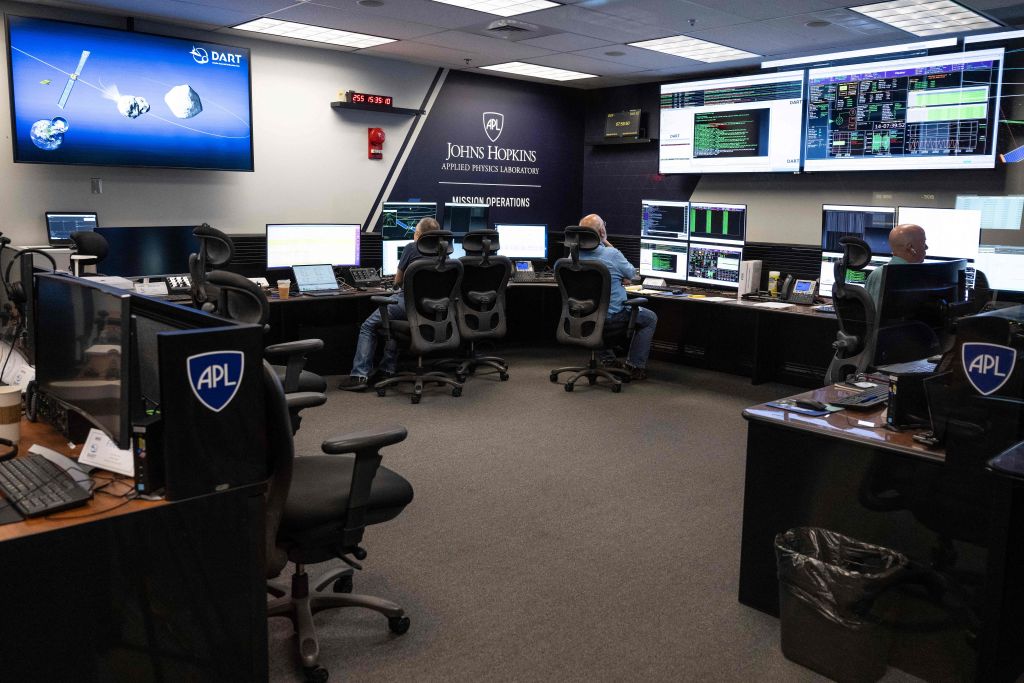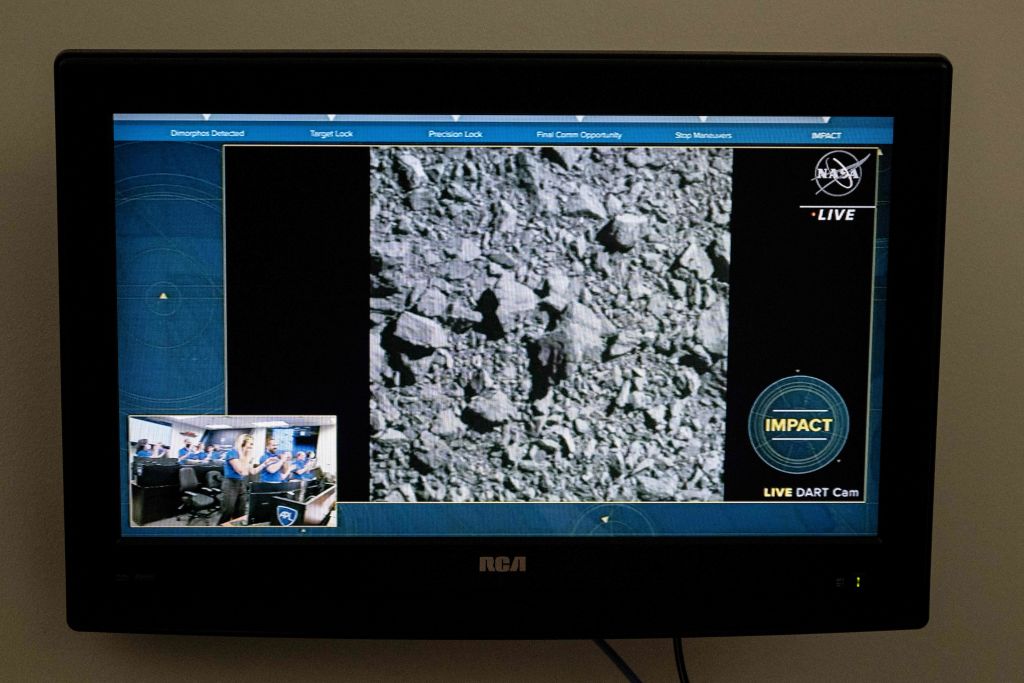The mission managers at NASA spent $330 million to send a refrigerator-sized spacecraft 7 million miles (11 million km) into space and punch an asteroid in the nose. And we should all be very glad they did, because today the Earth feels a little bit safer than it did yesterday.
The spacecraft, known as DART (for Double Asteroid Redirection Test), was launched last November, and its sole job was to fly out to the small, 160 m (525 ft.) asteroid Dimorphos, and crash into it at at 22,500 k/h (14,000 mph). Dimorphos is a moonlet of the larger, 780 m (2,560 ft) asteroid Didymos, making one revolution around its parent rock every 11 hours and 55 minutes. The purpose of the cosmic collision? To see if DART’s impact could nudge Dimorphos, speeding it up slightly and shortening its orbit around Didymos. Neither Dimorphos nor Didymos pose any danger to Earth, but other asteroids out there do pose a potential collision risk to our planet. The DART impact was intended as a test of the kind of deflection technology that might one day be necessary to save Earth from just such a killer rock.
The impact took place on Sept. 26 and ever since, NASA has been tracking Dimorphos’ orbit. To declare the mission at least a minimal success, the space agency calculated that DART would have to accelerate Dimorphos by 73 seconds or more. To declare the mission a triumph, NASA was hoping for as much as 10 minutes. Yesterday, at a press conference at the Kennedy Space Center in Florida, the DART team announced its findings, and the actual results blew the doors off of even the most optimistic estimates: the collision accelerated Dimorphos by 32 minutes, shortening its orbit to 11 hours and 23 minutes.
“This mission shows that NASA is trying to be ready for whatever the universe throws at us,” said NASA Administrator Bill Nelson when the results were released. “NASA has proven we are serious as a defender of the planet.”
Lori Glaze, NASA’s director of planetary science, added: “Let’s all just kind of take a moment and soak this in. For the first time ever, NASA has changed the orbit of a [celestial] object. The whole world has been watching this since DART impacted Dimorphos two weeks ago.”

Taking the measure of the tiny asteroid’s changed orbit was no small feat. Ever since the collision, four optical telescopes in Chile and South Africa, and two radio telescopes, in Goldstone, Calif.; and Green Bank, W. Va., have been keeping a steady watch on the moonlet, timing the slight dimming in Didymos’ reflectivity as Dimorphos passes in front of it. Orbiting 535 km (332 mi) above the Earth, the Hubble Space Telescope also trained its eye on the Didymos-Dimorphos system, capturing images not just of the asteroids themselves, but of the huge plume of ejecta—a debris trail of rock and dust—that the impact blasted thousands of kilometers into space. It is the size and power of the ejecta trail that is thought to account for the fact that the 32-minute acceleration so dramatically exceeded NASA’s original estimates.
“It looks like the recoil from the ejecta blasted off the surface was a substantial contributor to the overall push given to the asteroid, in addition to the push of the spacecraft directly impacting it,” said Tom Statler, DART program scientist.

Just what the implications of the DART results are for planetary defense is yet to be determined. The principle has been proven—that it’s possible to change the velocity of a cosmic object—and that is a good start. Accelerating or slowing a space rock that was headed our way would prevent the Earth and the asteroid from arriving at the same point in space at the same time, allowing us, effectively, to dodge a cosmic bullet.
“The key point of this type of technique is to just give that little nudge such that the asteroid crosses over Earth’s path, either just before we get there or just after we’ve gone by,” said Nancy Chabot, DART science coordinator at the Johns Hopkins Applied Physics Laboratory in Laurel, Md.
But Dimorphos is both a harmless and relatively static object—a known rock that keeps its distance at a known spot in space, never venturing anywhere near Earth. So as a target for celestial skeet-shooting it served its purpose well. Much more troubling is the huge population of wild rocks out there—asteroids that fly free through the solar system and could one day come our way.
The good news is, NASA is doing a pretty good job of finding those rocks and tracking their trajectory. The space agency’s Center for Near Earth Object Studies (CNEOS) keeps a running tally of asteroids that fly within 45 million km (28 million mi.) of Earth. That’s considered close enough that even a slight change in their trajectory could put us in their path. According to CNEOS’ census, there are 855 such asteroids measuring at least 1 km (0.62 mi.), and more than 10,000 that are at least 140 m (460 ft.) across.
NASA is reasonably confident that the 855 1-km asteroids—the kind that could cause planet-wide damage—represent 99% of the big rocks out there. But the 10,000 smaller ones are likely just 40% or so of the total population of asteroids near Earth in that size range. That’s a problem because there’s no way of knowing if any of the remaining 60% are on a possible collision course with Earth.
“That’s the size that really could cause regional devastation,” says Chabot, “so that while [they] wouldn’t wipe out the whole planet, they’re certainly of incredible concern.”

Protecting the planet from those kinds of objects means not only finding them, but finding them early—years before they come close to Earth, so that there’s time to get a deflector spacecraft out to an intercept point and divert them in time. What’s more, depending on the type of asteroid threatening Earth, an impactor spacecraft like DART could do more harm than good. Some asteroids, like Dimorphos, are essentially a single piece of solid rock. But others are more like rubble piles—loose agglomerations of debris held tenuously together by their collective gravity. Hit one of those with a DART-like probe and you may only make a bad problem worse, turning one large asteroid into a multiple warhead weapon.
“Breaking an asteroid is not really the best way to defend yourself from it because then instead of having one large object heading for you have a lot of little objects heading for you,” says Statler. “And that’s not better.”
An asteroid like that would require a different kind of deflection system—a spacecraft with a powerful enough engine that it could land on the surface of the object and gently propel it onto a different course. That kind of deflector, while often discussed, is not currently in NASA’s development pipeline.
Still, for the moment, at least, the space agency can allow that to be tomorrow’s problem and instead celebrate yesterday’s success—one critical step toward making the Earth a little bit safer. “All of us have a responsibility to protect our home planet,” Nelson said. “After all, it’s the only one we have. This is a watershed moment for planetary defense and all of humanity.”
More Must-Reads from TIME
- Donald Trump Is TIME's 2024 Person of the Year
- Why We Chose Trump as Person of the Year
- Is Intermittent Fasting Good or Bad for You?
- The 100 Must-Read Books of 2024
- The 20 Best Christmas TV Episodes
- Column: If Optimism Feels Ridiculous Now, Try Hope
- The Future of Climate Action Is Trade Policy
- Merle Bombardieri Is Helping People Make the Baby Decision
Write to Jeffrey Kluger at jeffrey.kluger@time.com